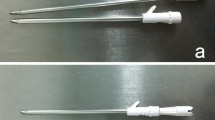Abstract
Background
The pinch and turn-over technique was developed to minimize the incision in the manual subdermal excision of apocrine glands in axillary osmidrosis for the best cure and fewest complications.
Methods
Through a 2-cm-long incision, peripheral subdermal tissue was excised by the technique under direct vision using intravenous anesthesia and tumescent technique. Ninety-nine axillae in 50 patients including seven secondary cases were operated on from 2009 to 2018. Long-term follow-up (average 30.3 months) could be done on 40 patients with questionnaires consisting of four-point ordinal-scale questions regarding osmidrosis grade, hyperhidrosis grade and satisfaction. For systematic review regarding incision length, 220 articles from 1962 to 2018 were reviewed with the search terms “osmidrosis” or “bromhidrosis.”
Results
Thirty-five and 30 of 40 respondents (87.5% and 75.0%) had excellent or good postoperative results in osmidrosis and hyperhidrosis grade. Postoperative improvement of osmidrosis grade (from 2.53 to 0.80) and hyperhidrosis grade (from 1.88 to 0.95) was statistically significant (p < 0.01). Thirty-four patients (85.0%) reported very satisfactory or satisfactory. Hematoma (2.0%), hyperpigmentation (5.0%), infection (5.0%) and noticeable scar (2.5%) were rare. Necrosis of flap margins was frequent (27.3%) but necessitated revision in two cases (2.0%). Among eleven articles found to describe incision length in pure manual subdermal excision, this technique provided the shortest incision compared with eight direct subdermal excision methods with an average incision length of 5.0 cm.
Conclusions
This technique offers an open, direct and selective approach with a short incision. It could maintain the best efficiency while neutralizing negative side effects of conventional manual subdermal excision for axillary osmidrosis.
Level of Evidence IV
This journal requires that authors assign a level of evidence to each article. For a full description of these evidence-based medicine ratings, please refer to the table of contents or the online instructions to authors www.springer.com/00266.








Similar content being viewed by others
References
Park YJ, Shin MS (2001) What is the best method for treating osmidrosis? Ann Plast Surg 47:303–309
Kim JR, Cha JH, Na MH, Kim YW, Park HJ, Lee DJ, Kim HJ (2003) Comparison of treatment effect between superficial suction and subdermal excision in osmidrosis. J Korean Soc Plast Reconstr Surg 30:15–19
Ha SU, Lee KC, Park JH, Park JM, Kim SK, Sohn HS, Baek CY, Jung GY, Song KH (2004) A comparative evaluation of various axillary osmidrosis treatment. J Korean Soc Aesthet Plast Surg 10:84–90
Shin JY, Roh SG, Lee NH, Yang KM (2017) Osmidrosis treatment approaches: a systematic review and meta-analysis. Ann Plast Surg 78:354–359
Kim KY, Cho SD (2008) Long term follow up of surgical treatment of axillary osmidrosis and hyperhidrosis by instrumental shaving and manual shaving. J Korean Soc Plast Reconstr Surg 35:709–715
Shim HS, Min SK, Lim JS, Han KT, Kim MC (2013) Minimal subdermal shaving by means of sclerotherapy using absolute ethanol: a new method for the treatment of axillary osmidrosis. Arch Plast Surg 40:440–444
Choi MS, Kim WS, Kim HK, Bae TH (2010) A clinical case of axillary web syndrome after glandular tissue and skin removal for axillary osmidrosis. J Korean Soc Plast Reconstr Surg 37:301–303
Yoo JW (1995) The comparative clinical and histological study of manual and inaba method in osmidrosis axillae. J Korean Soc Aesthet Plast Surg 1:227–232
Tung TC, Wei FC (1997) Excision of subcutaneous tissue for the treatment of axillary osmidrosis. Br J Plast Surg 50:61–66
Yim YM, Choi JW, Kim GH (2005) The treatment of osmidrosis axillae by use of modified Skoog’s method. J Korean Soc Plast Reconstr Surg 32:245–249
Ahn SY (2005) Surgical treatment of axillary osmidrosis. J Korean Med Assoc 48:653–660
Liu X, Mao T, Lei Z, Fan D (2010) A simple and practical method for axillary osmidrosis resection. J Plast Reconstr Aesthet Surg 63:e420–421
Liu Q, Zhou Q, Song Y, Yang S, Zheng J, Ding Z (2010) Surgical subcision as a cost-effective and minimally invasive treatment for axillary osmidrosis. J Cosmet Dermatol 9:44–49
Ding Z, Zheng J (2013) A comparison of two different sub-dermal trimming techniques for the treatment of axillary osmidrosis. J Plast Reconstr Aesthet Surg 66:1569–1574
Zhao H, Li S, Nabi O, Hu L, Gao X, Luo F (2016) Treatment of axillary bromhidrosis through a mini-incision with subdermal vascular preservation: a retrospective study in 396 patients. Int J Dermatol 55:919–925
Shin JY, Roh SG, Lee NH, Yang KM (2017) Negative pressure wound therapy as effective and comfortable management after treatment of osmidrosis. Aesthet Plast Surg 41:121–125
Han X, Li F (2013) Percutaneous ethanol injection for treatment for axillary osmidrosis. Clin Exp Dermatol 38:484–488
Kim HG (2014) A new osmidrosis procedure, the scrape and suction technique: review of 4,322 patients. Aesthet Plast Surg 38:282–287
Ou LF, Yan RS, Chen IC, Tang YW (1998) Treatment of axillary bromhidrosis with superficial liposuction. Plast Reconstr Surg 102:1479–1485
Tung TC (2001) Endoscopic shaver with liposuction for treatment of axillary osmidrosis. Ann Plast Surg 46:400–404
Li H, Wang B, Zhang Z, Ke MS, Yang S (2009) A refined surgical treatment modality for bromhidrosis: double w incision approach with tumescent technique. Dermatol Surg 35:1258–1262
Lim DW, Park J, You YC, Yang WY, Lee W (2005) The effectiveness of fibrin glue using dermal shaving at osmidrosis. J Korean Soc Aesthet Plast Surg 11:93–98
Bisbal J, del Cacho C, Casalots J (1987) Surgical treatment of axillary hyperhidrosis. Ann Plast Surg 18:429–436
Wu WH, Ma S, Lin JT, Tang YW, Fang RH, Yeh FL (1994) Surgical treatment of axillary osmidrosis: an analysis of 343 cases. Plast Reconstr Surg 94:288–294
Author information
Authors and Affiliations
Corresponding author
Ethics declarations
Conflicts of interest
No conflicts of interest were declared.
Rights and permissions
About this article
Cite this article
Lee, ET. Shortening of Incision by “Pinch and Turn-Over Technique” in the Treatment of Axillary Osmidrosis. Aesth Plast Surg 43, 267–277 (2019). https://doi.org/10.1007/s00266-018-1263-2
Received:
Accepted:
Published:
Issue Date:
DOI: https://doi.org/10.1007/s00266-018-1263-2




